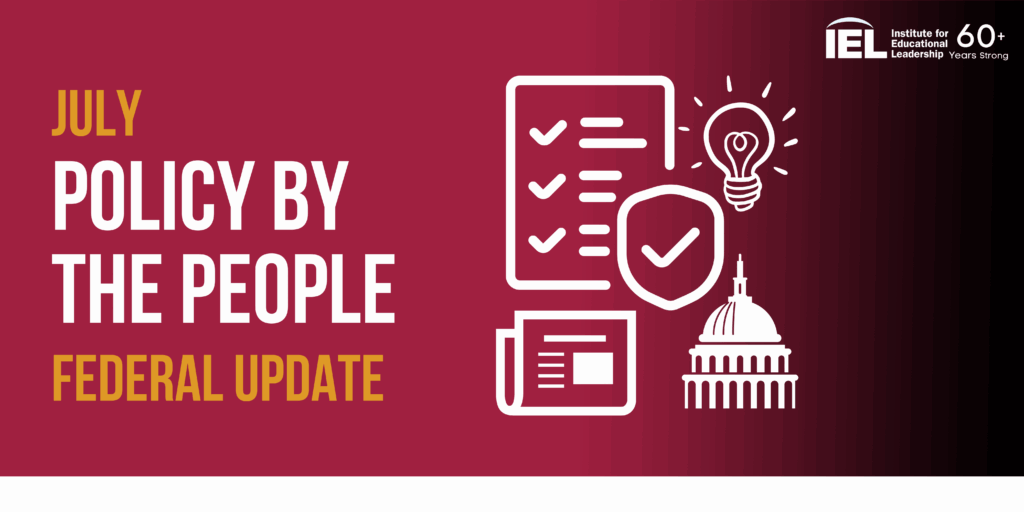*Please note: This update may not include all the changes currently happening in the federal government.
Here’s what’s been happening in federal education policy in July, and what lies ahead.
The U.S. Congress
The Reconciliation Process Reaches the End: The Reconciliation Bill for FY25, also known as the One Big Beautiful Bill, was passed by the House and Senate and signed by the President on July 4th, 2025. This bill makes most of President Trump’s tax cut from 2017 permanent, increases the child tax credit to $2,200, and makes provisions for no tax on tips. However, to compensate for the reduction in tax revenue, Congress made cuts to both Medicaid and SNAP benefits. These benefit cuts are expected to impact tens of millions of Americans over the next decade.
Fiscal Year 2026 Appropriations Process Continues: With the release of President Trump’s budget on May 30th and the end of the Reconciliation process, the FY25 Appropriations process has begun in earnest. Two of the twelve Appropriations bills have passed in the House. The House Appropriations Committee is now expected to mark up the FY2026 Labor, Health and Human Services, Education, and Related Agencies bill in the first week of September. The Senate may attempt to pass a minibus, or a set of appropriations bills, before the August Recess.
Chairman Walberg Announces Intention to Gradually Dismantle ED: The Chairman of the House Committee on Education and Workforce, Representative Tim Walberg (R-MI-5), announced his intention to dismantle the U.S. Department of Education through smaller bills. Secretary of Education McMahon announced her plan to work with Congress and Chairman Walberg to support this.
The U.S. Department of Education
Billions in Education Funding Released: On June 30, the U.S Department of Education announced that it would be withholding $6.8 billion in federal funding, initially set to be released on July 1. The Office of Management and Budget announced that the money was under review to ensure alignment with the Trump Administration’s policy priorities. However, after pressure from Governors, states’ attorneys general, national organizations, and Republican and Democratic members of Congress, the Department released the funds in two rounds. The U.S. Department of Education released $1.3 billion for after-school funding (21st Century Community Learning Centers) on July 18th, and after continued pressure, released the remaining $5.8 billion for teacher training, adult education, and services to support migrant students and English Language Learners.
Department of Education Announces Workforce Partnership with Department of Labor: On July 15, the U.S. Departments of Education (ED) and Labor (DOL) announced the implementation of a workforce development partnership to create an integrated federal education and workforce system. These actions come after the Supreme Court overturned a federal judge’s hold that blocked broader efforts to dismantle the ED. The ED will provide oversight of workforce programs like WIOA and Perkins funds, while the DOL will handle the administrative and technical assistance side. For more on this partnership, review this fact sheet from the ED.
The ED Announces Acting Commissioner of National Center for Education Statistics (NCES): On May 30, the ED announced that Dr. Matthew Soldner will serve as the Acting Commissioner of the National Center for Education Statistics (NCES). Soldner has served as the Acting Director of the Institute of Education Sciences (IES) since April 2024.
New Trump-Vance Political Appointees at the ED: On July 16, the ED announced seven new Trump-Vance appointees, including two appointees to the Office of Special Education and Rehabilitative Services.
The White House
The President Eyes Recissions For the ED: The White House’s first Recissions request was recently approved, clawing back $9 billion for public broadcast and foreign aid. It was reported by Politico that the White House intends to send Congress a second request to claw back FY25 Congressionally appropriated funds, with a focus on the U.S. Department of Education.
The U.S. Supreme Court
SCOTUS Clears Way for Dismantling the Department of Education: On July 14, the Supreme Court agreed that the Trump administration can resume the reduction in force at the Education Department, laying off more than a thousand workers. The Secretary of Education, Linda McMahon issued a press release in response to this decision, linked here.
Events & Resources
Webinars & Capacity Building Events 💻
- IEL Virtual Check-In: Understanding Recent Supreme Court of the United States Decisions & Actions on July 30, 3:00 pm ET
- Federal Advocacy Update Call: Impact of One Big Beautiful Bill on Local Governments and What’s Next in Congress on July 30, 4:00 pm ET. National League of Cities
- Student Connectedness Fosters Attendance and Engagement on August 6, 3:00 pm ET. Attendance Works
New Research, Reports, & Analysis 📝
- Legal experts weigh in on the implications of the 2025 Supreme Court term for K-12 education by Brookings Institute
- A Framework for State Leaders to Advance Summer Learning by the Education Committees of the States
- The Educators Students Deserve: Four State Policy Approaches by The National Association of State Boards of Education (NASBE)
- Education Roadmap for Governors by Colorado Governor Jared Polis, National Governors Association (NGA)
- Creating Safe and Supportive Schools by The Learning Policy Institute
IEL Policy Updates 📜
- IEL Releases 2025 State Blending & Braiding Funds Brief
More than 8 states directly fund Community Schools, and over 30 states support initiatives aligned with Community Schools. This brief highlights practical strategies, state examples, and funding sources that Community School leaders and advocates can leverage to continue supporting students and families, regardless of changes in federal funding.
